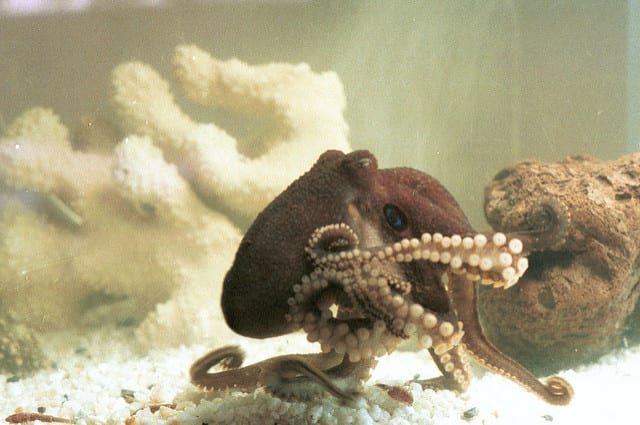The long-awaited sequel to Pixar's Finding Nemo, Finding Dory, features a new major character named Hank, an octopus who helps Dory in her journey home. Hank's creation took longer than any other character because octopus tentacle movement and behavior is so difficult to mimic. Animators needed two years to animate just one scene with Hank!

Boneless but dexterous
Octopus tentacles, like the rest of their bodies, don't have bones. To make up for it, they move in a way that's surprisingly similar to elephant trunks and mammalian tongues. These types of appendages are known as a muscular hydrostats, and they are in charge of both the rigidity and the movement of the appendage. Muscular hydrostats are distinct from other types of appendage-controlling muscles: the bicep, for example, is attached to the bone and therefore only controls movement while the bone is responsible for rigidity.
On top of these properties, octopus arms have “minds of their own:†rather than being controlled by the octopus' central nervous system, each tentacle is controlled by its own cluster of nervous tissue. In fact, the tentacles contain most of the nervous system of the octopus; the octopus devotes up to two-thirds of its entire mass of nerves to its arms. Can you imagine if your limbs had the capacity to respond to outside stimuli without your permission?
Don't freak out, but they actually do all the time–they're known as reflexes. The difference between this phenomenon in humans and octopuses is that the nerves in our spinal cords control these automatic movements, rather than the limbs themselves reacting. This means that if our arms get chopped off (which hopefully won't happen!), they can no longer respond to stimuli the same way as when they are attached— but octopus tentacles can! Even after severance, an unattached octopus arm can still react to stimuli, as you can see in the photo below. Creepy!

Engineering tentacles
So, what's the point of me telling you about this? There are actually some real-world applications of researching octopus arms, besides it being super awesome. Researchers are working to harness the unique movement of octopus tentacles for robotics. The OCTOPUS project is a collaborative effort to create a robotic octopus, in order to further the robotics industry by making submersible, soft, and flexible robots, while increasing understanding of octopus and cephalopod physiology.
This process of replicating octopus movement may sound like something from a science-fiction novel, but this is known as biomimicry, the engineering of man-made tools that “mimic†the processes used in the natural world. A well-known example of biomimicry is Velcro, which was inspired by burdock burrs, those annoying seed dispersal stickers that get stuck in your socks or your dog's fur. This example definitely has a real-world use — I'm sure you use Velcro weekly — but what could robotic octopus tentacles possibly be used for?
Octopus tentacles have the potential for a wide array of practical applications because they can access small areas and tightly grasp objects. This could be particularly useful for surgeons needing to remove small objects during arthroscopic surgery. Sometimes tweezers just won't cut it.
Building a robotic octopus requires new materials that have different flexibilities and textures that could have further use in other industries. The emergence of robotic octopus tentacles requires several new technologies to be developed, including sensorized skin, which has the potential to give feeling to prosthetic limbs. If a skin could be developed that mimics the octopus's ability to change color and texture, even invisibility cloaks could one day be possible (Harry Potter-esque or otherwise)!
However, roboticists and surgeons aren't the only ones who can benefit from a robotic octopus. In 2010, the European Union established a directive stating that no research on octopuses or other cephalopods may be conducted. Production of a robotic octopus would allow researchers to continue to study octopus movement and at the same time comply with this directive. The use of any robotic animal decreases the need for live animals and helps eliminate unnecessary suffering.
Personally, the thought of robotic octopuses not only sounds slightly disgusting but also totally awesome — now I kind of want one. Maybe I'll name it Hank.
 Holly McQueary is a PhD student in the Dept. of Genetics at the University of Georgia. When she's not buried under a pile of academic papers, she can be found in her kitchen baking a batch of chocolate chip cookies, crocheting awkwardly-shaped dishcloths, or dancing the night away with her BFFs. Solely based on diet, she is approximately 40% tacos and 60% caffeine. Holly can be reached at hmcqueary@uga.edu and you can follower her on Twitter @HollyMcQueary. Holly McQueary is a PhD student in the Dept. of Genetics at the University of Georgia. When she's not buried under a pile of academic papers, she can be found in her kitchen baking a batch of chocolate chip cookies, crocheting awkwardly-shaped dishcloths, or dancing the night away with her BFFs. Solely based on diet, she is approximately 40% tacos and 60% caffeine. Holly can be reached at hmcqueary@uga.edu and you can follower her on Twitter @HollyMcQueary. |
About the Author
- athenssciencecafehttps://athensscienceobserver.com/author/athenssciencecafe/April 17, 2020
- athenssciencecafehttps://athensscienceobserver.com/author/athenssciencecafe/April 12, 2020
- athenssciencecafehttps://athensscienceobserver.com/author/athenssciencecafe/April 3, 2020
- athenssciencecafehttps://athensscienceobserver.com/author/athenssciencecafe/March 30, 2020







